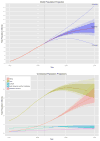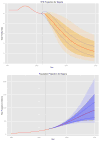World population stabilization unlikely this century
- PMID: 25301627
- PMCID: PMC4230924
- DOI: 10.1126/science.1257469
World population stabilization unlikely this century
Abstract
The United Nations (UN) recently released population projections based on data until 2012 and a Bayesian probabilistic methodology. Analysis of these data reveals that, contrary to previous literature, the world population is unlikely to stop growing this century. There is an 80% probability that world population, now 7.2 billion people, will increase to between 9.6 billion and 12.3 billion in 2100. This uncertainty is much smaller than the range from the traditional UN high and low variants. Much of the increase is expected to happen in Africa, in part due to higher fertility rates and a recent slowdown in the pace of fertility decline. Also, the ratio of working-age people to older people is likely to decline substantially in all countries, even those that currently have young populations.
Copyright © 2014, American Association for the Advancement of Science.
Figures



Comment in
-
Economics. Adjusting to the fertility bust.Science. 2014 Oct 10;346(6206):163-4. doi: 10.1126/science.1260504. Science. 2014. PMID: 25301602 Free PMC article. No abstract available.
-
Population growth: peak probability.Science. 2014 Oct 31;346(6209):561. doi: 10.1126/science.346.6209.561-a. Science. 2014. PMID: 25359958 No abstract available.
-
Population growth: limits of food supply.Science. 2014 Oct 31;346(6209):561. doi: 10.1126/science.346.6209.561-b. Science. 2014. PMID: 25359959 No abstract available.
-
Sustainability: A meaty issue.Nature. 2017 Apr 26;544(7651):S18-S20. doi: 10.1038/544S18a. Nature. 2017. PMID: 28445446 No abstract available.
References
-
- UNAIDS. Global Report: UNAIDS Report on the Global AIDS Epidemic 2013. UNAIDS; Geneva, Switzerland: 2013.
-
- United Nations. World Population Prospects: The 2012 Revision. Population Division, Dept. of Economic and Social Affairs, United Nations; New York, NY: 2013.
-
- Lee RD, Tuljapurkar S. Journal of the American Statistical Association. 1994;89:1175. - PubMed
-
- National Research Council. Beyond Six Billion: Forecasting the World’s Population. National Academy Press; Washington, D.C: 2000.
Publication types
MeSH terms
Grants and funding
LinkOut - more resources
Full Text Sources
Other Literature Sources

